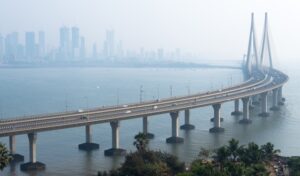Physical Address
23,24,25 & 26, 2nd Floor, Software Technology Park India, Opp: Garware Stadium,MIDC, Chikalthana, Aurangabad, Maharashtra – 431001 India
Physical Address
23,24,25 & 26, 2nd Floor, Software Technology Park India, Opp: Garware Stadium,MIDC, Chikalthana, Aurangabad, Maharashtra – 431001 India

By Vivek Saini
India faces a pressing challenge as nearly half of its public infrastructure is at risk due to climate change and urbanisation. A recent survey by CBRE, in collaboration with the Confederation of Indian Industry (CII), has brought to light the escalating concerns over the country’s infrastructure’s ability to cope with the increasing risks posed by natural and man-made disasters. The findings underscore the urgent need to adapt infrastructure to withstand these evolving threats and ensure long-term economic stability.
Unprepared for Disaster Management
CBRE’s report reveals that 50% of India’s public infrastructure is unprepared for disaster management. As urbanisation expands rapidly and environmental degradation worsens, the risks of floods, cyclones, and extreme weather events are rising. These incidents have caused significant disruptions, damaging critical infrastructure and affecting millions of lives. This underscores the need for improved disaster planning to safeguard India’s economic growth.
Anshuman Magazine, Chairman and CEO of CBRE India, Southeast Asia, and the Middle East, stressed that while infrastructure is central to India’s growth story, inadequate risk management hinders progress. “Infrastructure is essential for sustainable growth, yet without addressing these vulnerabilities, we face enormous setbacks,” he noted.
A Dual Threat: Climate Change and Man-Made Disasters
India’s infrastructure is not only threatened by climate change-induced natural disasters like floods, droughts, and extreme temperatures but also by various man-made hazards. The report also highlights that industrial accidents, cyberattacks, and public health crises are all on the rise, exacerbating the vulnerability of critical infrastructure. As urban areas continue to grow, with more high-density developments built in high-risk zones, the pressure on existing infrastructure has reached a breaking point. These areas are prone to more frequent and severe disruptions without proper urban planning and effective risk management strategies.
These dual threats aren’t isolated; they often reinforce one another. For example, extreme weather events caused by climate change can increase the likelihood of industrial accidents, such as chemical spills or power outages, disrupting essential services like healthcare and transportation. Similarly, the rapid growth of digital infrastructure without adequate cybersecurity protections can make critical systems vulnerable to cyberattacks during disaster recovery efforts. CBRE’s findings highlight the need for multi-dimensional risk assessments, ensuring infrastructure can withstand environmental shocks and man-made risks that could further weaken the nation’s already fragile systems.
The Call for Stronger Risk Management
To address these risks, CBRE experts recommend a shift towards innovative and agile infrastructure practices. Regular maintenance, timely upgrades, and thorough inspections can significantly bolster the resilience of public assets. “Addressing these risks requires proactive, forward-thinking strategies that anticipate future challenges,” said Rajesh Pandit, Managing Director of Global Workplace Solutions at CBRE. He stressed the importance of adopting futuristic designs and risk management frameworks that adapt to evolving threats.
This call for enhanced risk management aligns with global best practices, where resilience-building initiatives play a central role in safeguarding infrastructure against future risks. The idea is to integrate innovative technologies and climate-resilient designs that are efficient and equipped to handle unforeseen disasters.
The Road Ahead
With India’s infrastructure serving as the backbone of its economic and social development, the need to future-proof these assets is more pressing than ever. The CBRE survey serves as a wake-up call for policymakers, city planners, and businesses, urging them to prioritise climate resilience and disaster preparedness in their long-term planning. Investing in resilient infrastructure is not just an option—it’s necessary to ensure that India’s growth trajectory remains intact despite the looming challenges posed by climate change and urbanisation.
As India faces an increasingly volatile future, one thing is clear: the time to act is now. Effective disaster preparedness, climate adaptation, and robust infrastructure planning will determine how well the country can weather the storms ahead.
References:
Banner image:
Photo by Previn Samuel on Unsplash